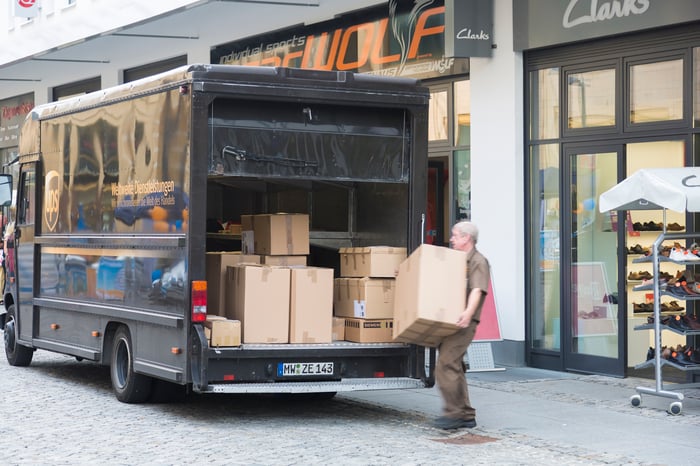Online shopping is disrupting the retail world in a huge way and having a similar impact on shipping companies like United Parcel Service (UPS 0.34%). The assumption is that more online shopping is good for shippers, but that's too simple a forecast. Yes, this radical shift in consumer habits is a long-term positive for the shipping industry's outlook. But it hasn't been a smooth ride. Here are two of the biggest challenges facing UPS today as a result of the explosive growth in online shopping.
1. Christmas
It might sound silly, but in each of the last few years, there's been too much holiday cheer for UPS. The issue is easy to see, people send more packages (gifts) during the end of year holiday period. That requires shipping companies like UPS and peer FedEx to handle an elevated level of packages over a very short period of time. And with important delivery dates that leave no wiggle room for mistakes.

Image source: Getty Images.
There have been some troubles... Google "UPS Christmas problems" and a slew of articles will pop up. The issue made big headlines in 2013 when weather combined with an unexpected surge in last minute deliveries to really gum up the works.
But the problems that UPS faced in 2013 haven't exactly been solved, though it appears things are getting better for the delivery specialist. For example, UPS started to fall behind early in the 2016 holiday season with on-time delivery rates falling from a typical 98% (or so) to 96.3% in mid-December. That's tens of thousands, maybe even hundreds of thousands, of customers that didn't get what they wanted when they wanted. That said, 96.3% was up from 95% in the same week in 2015, according to ShipMatrix, Inc.
That's just a quick example that UPS hasn't gotten all the kinks out even after a few years of trouble. Is this issue going to result in UPS going out of business? No, it's really a story of too much of a good thing. But it does present problems, including profit margins dipping at a time when you'd think UPS would be making the most money. Simply put, UPS needs to find a way to make the fourth quarter more profitable.
UPS Gross Profit Margin (Quarterly) data by YCharts
It's experimenting with pricing, including charging more during the peak holiday season and is now even looking to charge retailers extra if they fail to live up to projected shipping estimates. It's also switched to dimensional pricing, charging based on a combination of weight and size. These moves show a proactive management team, but the graph above shows that the problem isn't solved yet.
2. Capital spending
The next big issue stemming from increasing online sales is that UPS has been forced to invest in new infrastructure to handle the flood of packages. Indeed, charging more for packages is only half the picture, since the company still has to have enough throughput to deal with them. Just take a look at the graph below and it will be pretty clear that UPS has started to ramp up its capital spending in a big way.
In late 2014 the company expected capital spending to be between 4.5% and 5% of sales between 2015 and 2019. Capital spending in 2016 was roughly 4.8% of sales, toward the high end of that, but within the range. It's set to jump to over 6% this year.
UPS Capital Expenditures (TTM) data by YCharts
There's no question that this spending is needed to deal with a quickly changing market environment. So the investment is good to see and, with any luck, will eventually help to resolve some of the holiday problems that have bogged the company down in recent years. However, capital spending eats into profitability.
The spending so far has helped to alter the trajectory of UPS's costs, holding them relatively flat over the last few years. But clearly, the spending isn't over yet, with the company upping its spending as a percentage of revenue by roughly 1.2 percentage points this year. It's a headwind to growth that, at this point, hasn't completely solved the volume problems UPS is facing during the holidays. UPS might have to keep spending like this until it has gotten a handle on the growth of online shopping.

UPS is doing better on costs, but it still hasn't solved the volume issue. Image source: United Parcel Service.
Growing pains
Ongoing troubles during the holiday season and the costly investments needed to deal with consumers' shift toward online shopping are two of the biggest issues investors have to watch at UPS. There's really no risk of UPS going out of business, but if it can't adjust to the changing market it could find itself making less money than hoped and even facing new competitive threats. On that score, it's interesting to note that Amazon.com has been building up its own delivery capabilities. In other words, don't just assume that UPS will solve these issues, watch to make sure it does.







